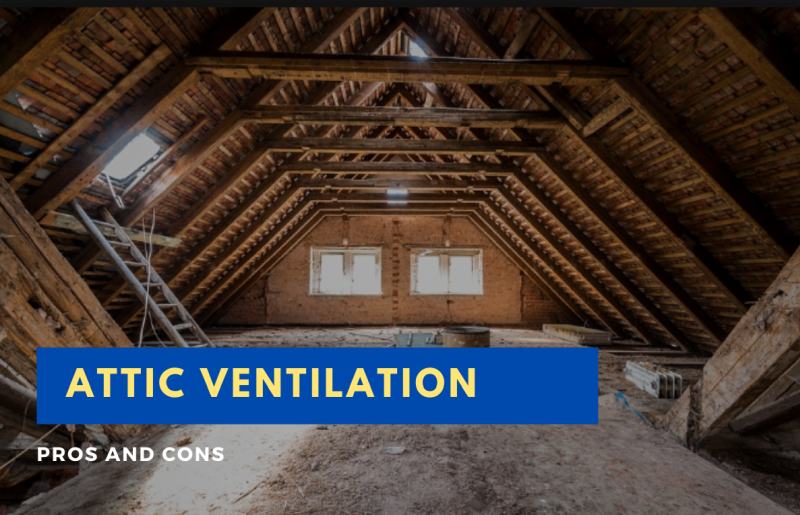Table of Contents
What Is Attic Ventilation?
From powered fans to turbine vents that operate. Homeowners within the Atlanta area have many options for attic ventilation. Unluckily, not every roof ventilator system offers advantages for the houses.
That is why it takes a careful examination of both home exhaust and insulation to get it right. Here are the pros and cons of ventilating your attic and how to determine what is right for your home.
Read More: Pros and Cons of Argumentation – Essay Tips
Pros of Attic Ventilation
There are numerous advantages to installing an exhaust fan, but below are the foremost important benefits:
Asphalt Roof Protection
Having good attic ventilation can help prevent premature ageing of your roof. Many attics have old and degraded insulation. Or dropping insulation, and accustomed air escapes into the attic.
Also, there are usually issues with the passive ventilation system. There are apertures beneath the eaves exclaimed soffit venting, which is missing, inadequate, or even painted over.
A Cooler House
Besides defending a shelter, reducing your attic warmth during warm weather. It will make your home more comfortable. A hot attic will create temperature differences within the family. With the second level of a house being much warmer than downstairs.
Read More: Pros and Cons of Gene Therapy – Essay Tips
During the weather, the sun will heat the roof, and this heat will transfer down to the attic, through the wood framing and wood sheathing. According to Oregon State University, the attic acts like a “heat trap” like how a car heats up when the windows closed on a hot day.
Stop Mold Growth
A ventilated attic can lead to mould growth, during cold or warm weather months. During hot weather, you’ll have the A/C cranking out cold air within the home’s interior, and there’ll be hot air within the attic.
When two different temperatures meet, condensation and moisture can form in the attic. When there is darkness, water, and a food source mould growth can occur.
Drop Ice Damming
Ice damming is a strange phenomenon of a ventilated attic. And it only happens during cold weather. According to Attic Insulation Toronto, ice damming can have many causes. Also, result in significant issues.
If the attic ventilated and insulated, the warm air can leak into the attic from the home’s interior. And this will cause snow to melt on the roof. When this snow re-freezes, it turns to ice. And since the part of the ceiling closer to the eave is that the coldest, ice forms on the roof edge.
Read More: Pros and Cons of Designer Babies – Essay Tips
And when more snow melts, it falls back down the roof to this mass of ice. Which now acts as a dam, holding back proper roof drainage. This “dam” can cause water damage to the roof sheathing, and to the home’s wall — damage to wood joists, drywall, etc.
This water intrusion into the house also can cause mould growth.
Cons of Attic Ventilation
There are some potential negatives to installing an attic fan. Here are some documented possible disadvantages to attic fan:

Carbon Monoxide Risk
Suppose you have natural gas burning appliances such as water heaters or furnace. Then installing a powered attic fan can lead to carbon monoxide poisoning.
[Reminder: This thought doesn’t apply to solar-powered or turbine garret propellers. They are less powerful.]According to the Home Improvement Contractors, attic fans can create negative air pressure when the home’s interior air becomes negative. It can pull the water heater combustion gases into the house, rather than venting to the exterior.
Read More: Pros and Cons of Implant Birth Control – Essay Tips
An easy way to find out if your home has a negative air pressure is to open a window when the attic exhaust fan is running. If air is being pulled INTO the house, then it’s under negative pressure.
Yet, this risk can be mitigated if you follow the directions of the powered attic fan. It’s also essential to always have a carbon monoxide gas detector on each level of the house if you’ve got gas-burning appliances or an attached garage.
May Increase Energy Costs
Attic fans don’t decrease the energy usage of a home’s HVAC system.
The critics specify that the energy needed to run the attic vent fan offsets. Any additions by enhancing attic ventilation as a consequence of the ventilator. Also, the thermostatic attic fan may be pulling conditioned air from the home’s interior. Thereby decreasing even further any energy gains as mentioned by the Energy Department.
Read More: College Essay About Pros and Cons of Genetically Modified
Also, factoring the value of the attic ventilation fan. It may take over 30 years to regain the costs through increased energy efficiency due to increased attic ventilation.
Roof Leak Risk
Any time you put in something onto a roof, there’s an opportunity of a roof leak. The probability may be increased if improper flashing used. Or if the roof penetrations are not maintained. Of course, a gable attic vent fan minimizes this risk because it isn’t installed on the roof but the gable wall.
Most attic fans are not designed to prevent water intrusion during hurricanes. Attic fans designed to keep out “normal” rainfall. But during storms, the facility of the wind can push water up the roof in sheets.
Conclusion
Proper roof ventilation is often neglected as being an essential part of the construction. This approach often results in ice dams, moisture in attics, and avoidable roof issues. Focusing on proper roof ventilation, mainly when including a secure ridge vent.
Read More: Pros and Cons of Trump for International Students – Essay Tips
It provides sustainable construction. Also, peace of mind for both the contractor and homeowner. Suppose you’re a contractor trying to find a standing seam metal ridge roof vent. That will make your roofing business more efficient and productive. Then it is the best choice for you.









 College Essay Tips On Pros and Cons of Air Flyer
College Essay Tips On Pros and Cons of Air Flyer